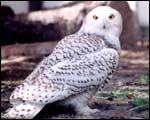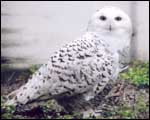 |
 |
 |
| Adult
Female |
Adult
Male |
Juvenile |
Snowies are Canada's largest species of owl. Females, as is true of most raptor species, are larger and more powerful than their male counterparts. A typical female Snowy Owl can reach a weight of 2000g and have a wingspan of over five feet. This owl is one of few North American owls that nests on the ground. The female creates a shallow depression in the ground known as a "scrape" within which she lays her eggs. The scrape is usually lined with moulted feathers. The male provides his mate with food, both for herself and chicks in the nest. Young fledge from the nest very quickly (within weeks) and subsequently hide in vegetation. These chicks are fed by the male directly.
Snowy Owls are diurnal birds (hunting during daylight hours) and lack the well developed facial discs of the nocturnal owls that rely more on sound to locate prey. They are predominantly white birds with black beaks, yellow to orange eyes and no ear tufts. They have extensive feathering on their toes which protects them from freezing in the far north. In addition, the feathers protect the feet from prey bites.
The Snowy Owl is one of few North American owl species that can be accurately sexed by plumage colouration. Heavily barred birds are female, while white birds are male (see above). Unfortunately, this is a very basic method and, although accurate for most encounters, does have one fault: Sub-adult males (below) are more heavily barred than adult males. It can take up to four years for a male Snowy Owl to reach his adult plumage. As a result, young males are sometimes mistaken for females (see below). Luckily there are a few secondary methods one can use to help differentiate (body size, for instance), but these often require a skilled and experienced eye.
 |
 |
sub-adult
male |
mature
female |
With the spread of West Nile Virus into North America and the subsequent infection of most owls at The Owl Foundation in 2002, we incurred devastating losses to both our permanent and releasable birds. Hardest hit were the northern species with 100% mortality. All twelve of our resident Snowy Owls were killed by the virus, as well as another seven releasables (five of which were bred at TOF). It was a shocking and heartbreaking summer.
Since then, The Owl Foundation has slowly been recovering a non-releasable breeding population. It can take several years for relationships to form and bonds to strengthen. Our 2005 breeding season resulted in three beautiful chicks from a single pair of damaged owls. All releasable Snowies are shipped by air to Churchill, Manitoba (the Arctic) for release after successfully completing live training. We hope the 2006 season proves to be as productive. In the meantime, we provide the owls with choices, space and protection from West Nile in our over 4000 sq. ft., completely mosquito screened Snowy Owl complex.
Vocalizations:
Snowy Owls are generally
quiet birds. Males become more vocal at the onset of breeding season (usually
May and June at TOF), producing a series of low grunting hoots, much as
male Great Horned Owls (Bubo virginianus)
do, to win over females. Some will also dance while vocalizing. This display
is formed by putting the head down and presenting the undersides of the
wings to a prospective mate. Warning screams (usually from females) and
singular hoots are also produced throughout the year. During food transfer
at the nest site both sexes will grunt.
Vocalizations |
||
|
|
||
| A
typical solitary hoot produced by a male. |
||
Hoot |
||
| |
||
| Vocals produced by a pair. Initially provoked by the hoot (as above) of the male (unrecorded), the female responds. She then precipitates another hoot from the male. Both begin grunting as the male passes by the female only to continue his "song" and dance in a nearby unit. | ||
|
|
||
| Grunts produced from a pair during food transfer at the nest. | ||
Food
Calls |
||
|
|
||
| Warning
vocalization by a female. |
||
Scream |
||
|
|
||
Contact
Us | Hours | Home
| Legal
© 2008 The Owl Foundation
Owl vocalizations recorded by Kara Kristjanson.
Unless otherwise stated, all photographs and sound files are the property of The Owl Foundation.
No images or sounds on this website are to be duplicated in any way without express written permission
from the party to which they belong.
If you are interested in receiving quality versions, please contact The Owl Foundation.
